Honoring the Tuskegee Airmen in Michigan
Editor’s note: In celebration of the department’s centennial anniversary, the Showcasing the DNR features series will highlight one story each month during 2021 that recalls various accomplishments of the department over the past century.
By WAYNE R. LUSARDI
Michigan Department of Natural Resources
Eric Bryant’s eyes fixed intently on the monitor.
“That’s my uncle’s airplane,” he said in almost a whisper.
Bryant’s uncle was Lieutenant Frank H. Moody, one of only a thousand African American pilots trained by the U.S. Army Air Corps during World War II.
Lt. Moody earned his wings at Tuskegee Army Airfield in Alabama in February 1944, and was later transferred to Selfridge Field at Mt. Clemens, for advanced training.
Seventy-seven years later, Lt. Moody’s nephew Eric Bryant flew with his family from Los Angeles to Detroit. They rented a car and drove to the resort village of Lexington on the southern shore of Lake Huron.
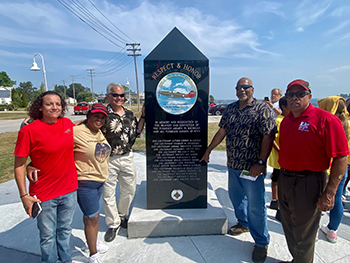
Their journey was a pilgrimage of sorts, filled with anticipation of learning about their own heritage, and perhaps bringing a sense of closure to a family tragedy that occurred so long ago.
Yesterday and today
Frank Heman Moody was born in Castle, Oklahoma, Dec. 18, 1921. He was the only son of Willie Moody of Lamar County, Texas, and Savannah Nelson of Arkansas Cherokee descent. Following the birth of his first sister, Flossie, in 1923, the Moody family moved to Los Angeles. In December 1925, Frank’s youngest sister Annie Mae was born in California. Annie Mae Moody married Clayton Bryant July 3, 1950, and four years later their son, Frank’s nephew, Eric Rodney Bryant, was born.
Although he is a recreational scuba diver and underwater explorer, Eric Bryant had never experienced the Great Lakes. I met him and his family when they arrived in Lexington.
As the state maritime archaeologist for the Michigan Department of Natural Resources, I serve as the principal investigator for many shipwreck archaeological projects. Bryant did not travel to Michigan to see a shipwreck, however.
He was here to see a wrecked airplane, specifically a P-39Q Airacobra, call number 221226. Manufactured by Bell Aircraft Corporation of Buffalo, New York, the Airacobra was 30 feet, 2 inches in length, and had a wingspan of 34 feet. The single-seat fighter airplane was powered by an Allison V-1710 engine and had a range of 650 miles, able to reach speeds of 385 mph. The aircraft was armed with a 37-millimeter cannon that fired through the propeller hub, and four .50-caliber machine guns.
|
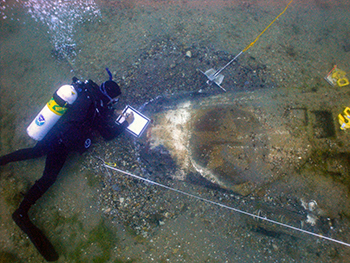
Learning to fly an Airacobra was no easy task, but Bryant’s uncle Frank Moody was up to the challenge. Moody earned his wings at Tuskegee Army Airfield in February 1944 and became part of an elite group of pilots belonging to the 332nd Fighter Group. They would come to be known as “Red Tails.”
After being commissioned a second lieutenant in the U.S. Army, Moody was transferred to Selfridge Field for advanced training. April 11, 1944, he took off with three other pilots to conduct live-fire gunnery exercises over lower Lake Huron.
According to the accident report, “The formation had just flown up to the gunnery range, was in level flight approximately 50 to 100 feet above the water, flying abreast with the flight leader slightly ahead, when the accident occurred.
“Lt. Moody had just fired two bursts into the water when small pieces were seen coming from the front right side of his ship. According to the testimony of witnesses, Lt. Moody’s ship gave off a trail of black smoke, raised its nose slightly, but then cart-wheeled into the lake.”
Lt. Moody was killed instantly. His body was later found by a group of boys on the shore of Lake Huron just north of the St. Clair River. He was returned to Los Angeles for burial with full military honors.
|
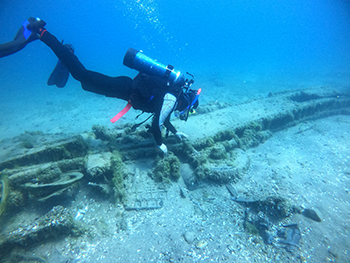
Revisited
On April 11, 2014, exactly 70 years to the day after the crash, David Losinski and his son Drew discovered a wrecked airplane while diving in Lake Huron. They were surveying the lake bottom where a tugboat and barge sank in 2012 when they happened across what they thought was an automobile door.
According to David Losinski, “A few yards later, we discovered a wing and knew we had found an airplane. We contacted Wayne Lusardi with the State of Michigan to see about getting a permit to put some of the airplane back together on the lake bottom to serve as a recreational dive site.”
The Losinski father and son team spent a year searching the lake bottom for parts of the airplane and clues to its demise. They eventually found the forward instrument panel that featured, along with a cluster of gauges, the airplane’s radio call sign that positively identified the wreck as the Airacobra flown by Lt. Moody.
In July 2015, I began suiting up for a dive from Losinski’s charter boat Dive Version. Drew and I jumped into the 70-degree water and descended 34 feet to the lake bottom.
Warm water usually means visibility is reduced because of algae blooms, but natural sunlight on that day allowed us to see 30 or 40 feet. The wings of Lt. Moody’s plane came into view immediately.
Although they are separated from the fuselage and missing portions of the flaps, ailerons and starboard wing tip, the wings are fairly intact. They are lying flat on the lake bottom and are partially buried in sediment.
A five-pointed white star insignia in a field of blue can be seen on the portside wing. Traces of a red border extend outboard of the star. A red, teardrop-shaped plastic running light is positioned on the dorsal surface near the portside wing tip. The two main landing gears are tucked up inside the wings, one with a tire still holding air from 1944.
The framework between the wings holds a collection of aircraft components including the throttle and mixture control levers, a Prestone coolant radiator, fragmented aluminum canopy frame containing glass fragments, two oil coolers, the armored glass windshield and the portside door.
|
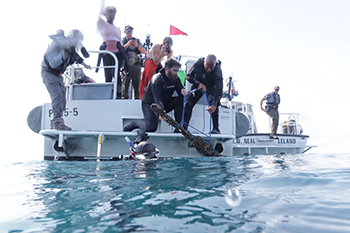
Drew Losinski and I did a half dozen more dives that day, as he served as my personal tour guide to the propeller and gear box, instrument panel, engine, tail, and finally, the machine guns.
It was easy to recognize the importance of this site. Although fragmented and spread out over a square mile of lake bottom, the Airacobra wreck would soon become the first of its kind associated with Tuskegee Airmen to be archeologically documented.
Following the preliminary site visit, the aircraft wreckage was issued Michigan archaeological site number 20SC177. I returned home to Alpena and immediately telephoned a friend, Erik Denson, who works as the chief electrical engineer for NASA at the Kennedy Space Center in Florida.
“The Tuskegee Airmen are my heroes,” Denson said. “And I will be proud to be part of this project.”
In August 2015, I returned to the airplane wreck site, this time with Denson and a group of volunteer divers from the National Association of Black Scuba Divers. We spent a week recording all visible artifacts and carrying on the work that David and Drew Losinski had started the year before.
At the conclusion of the 2015 field project, the team met with Dr. Brian Smith of the National Museum of the Tuskegee Airmen, then located at old Fort Wayne in Detroit.
Dr. Smith was equally excited to be part of the project. In 2018, he applied for and was issued an archaeological recovery permit from the State of Michigan.
|
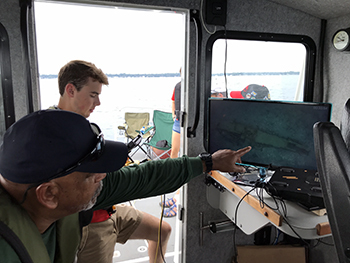
Dr. Smith and I, with the help of volunteer divers and Capt. Luke Clyburn of the Noble Odyssey Foundation, began the systematic recovery of a select group of artifacts from the site in July 2018.
The 2-inch-thick bulletproof windshield, the starboard side door manufactured by Hudson Motor Company, the forward instrument panel containing 16 gauges and the radio call sign, a wooden radio mast, and two sections of steel drive shaft that connected the engine to the propeller were carefully lifted from the bottom of Lake Huron.
Process
All materials recovered from submerged archaeological sites go through a lengthy process to preserve the integrity of the artifacts and allow them to be dried out, analyzed and exhibited.
The recovered artifacts were transferred to the state’s conservation laboratory located at the Great Lakes Maritime Heritage Center in Alpena, where I began the process of removing invasive mussels, stabilizing the deteriorating metals and recording all the details that can help interpret the wreck site.
As the artifacts were being cared for, plans were simultaneously developing to document and recover the remainder of the wreck site.
Michigan’s Department of Environment, Great Lakes, and Energy and the DNR renewed the archaeological recovery permit earlier this year. Dr. Smith and I organized a crew to continue documentation of the wreckage and removal of artifacts from Lake Huron.
Latest developments
Over the course of three weeks in August, 15 volunteer divers, two museum curators from the Michigan History Center and the Michigan Maritime Museum, seven DNR conservation officers, a half dozen Michigan State Police troopers, and an assortment of media and documentary filmmakers, including Evan Pittman of the television show “Wardens” and my son Nicholas, converged on the small town of Lexington.
Our mission was to record as much of the wrecked airplane as possible and, following meticulous documentation, recover many of the artifacts distributed across the lake floor.
|

Several hundred artifacts were measured, photographed and precisely mapped, all under the watchful eyes of video cameras. They were then retrieved and transported to Detroit and Alpena for conservation.
The final day of the 2021 field season started differently than the previous three weeks had. There would be no diving, so wetsuits and tanks were not necessary.
Instead, DNR conservation officers Craig Milkowski and Pat Hartsig helped my daughter Eva and her friend Josh, both engineering students at the University of Michigan, load a remotely operated vehicle on board a state patrol vessel.
Eric Bryant, his wife Sally and their daughter Lauren also climbed aboard, as did Tonja Anderson-Dell, who lost her grandfather in an Air Force plane crash in Alaska, and who helped me contact Lt. Moody’s relatives.
We motored the half-hour to the wreck site, dropped anchor, and Eva and Josh deployed the ROV. Conditions could not have been better, and almost immediately Bryant was able to see his uncle’s airplane for the first time on the oversized monitor.
Tears came to his eyes as he watched in amazement, and it was obvious that this was much more than an archaeological investigation of a wrecked aircraft. It was a dive into history – and into a man’s life.
Lieutenant Frank Heman Moody overcame unimaginable obstacles to become a Tuskegee Airman preparing to fight for his country. He was only 22 years old when he was tragically killed in Lake Huron.
His death was not in vain, and it has been an honor to help tell his story and ensure that his legacy will not be forgotten.
On Aug. 28, 2021, a memorial was dedicated at International Flag Plaza in Port Huron to honor the 15 Tuskegee Airmen killed in training accidents in Michigan in 1943 and 1944.
The Tuskegee Airmen’s impact on northeast Michigan, their contribution to the war effort and their ultimate sacrifice will long be remembered here and across the nation.
|
Check out previous Showcasing the DNR stories in our archive at Michigan.gov/DNRStories. To subscribe to upcoming Showcasing articles, sign up for free email delivery at Michigan.gov/DNR.
Note to editors: Contact: John Pepin, Showcasing the DNR series editor, 906-226-1352. Accompanying photos and a text-only version of this story are available below for download. Caption information follows. Credit Michigan Department of Natural Resources, unless otherwise noted.
Text-only Showcasing Story - Plane recovery
Bryant: Eric Bryant, nephew of Tuskegee Airman Lt. Frank H. Moody, examines the throttle and mixture controls recovered from his uncle’s wrecked P-39 Airacobra. (Photo by Wayne R. Lusardi)
Column: State maritime archaeologist Wayne Lusardi recovers the Airacobra control column. (Photo by Carrie Sowden)
Explore: Underwater videographer Nicholas Lusardi explores the Airacobra wings. (Photo by Wayne R. Lusardi)
Guns: One of four machine guns recovered from the wrecked airplane is lifted aboard a Michigan Department of Natural Resources patrol vessel. (Photo by Jamil Wilson)
Memorial: From left to right, Lauren Bryant, Tonja Anderson-Dell, Wayne Lusardi, Eric Bryant and Dr. Brian Smith at the Tuskegee Airmen’s memorial in Port Huron. (Photo by Nicholas Lusardi)
Sowden: Archaeologist Carrie Sowden documents the Allison V-1710 airplane engine. (Photo by Wayne R. Lusardi)
Watching: Eric Bryant observes his uncle’s wrecked airplane, while remotely operated vehicle technician Josh Beatty operates the underwater robot. (Photo by Wayne R. Lusardi)
Whitehead: Archaeologist Hunter Whitehead documents the Airacobra empennage, which is an arrangement of stabilizing surfaces at the tail of an aircraft. (Photo by Wayne R. Lusardi)
Wing: Michigan Department of Natural Resources maritime archaeologist Wayne Lusardi documents the portside wing of a Bell P-39 Airacobra wrecked in Lake Huron in 1944. (Photo by Erik Denson)
|